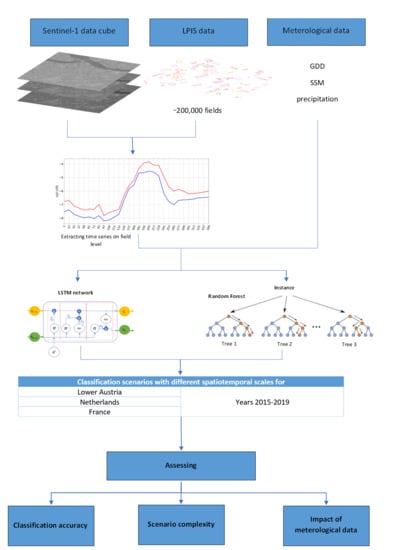Comparison of Long Short-Term Memory Networks and Random Forest for Sentinel-1 Time Series Based Large Scale Crop Classification
Abstract
:1. Introduction
1.1. Machine Learning Based Crop Classification
1.2. Applying Crop Classification Models on a Large Scale
- The model must be able to learn the discriminative characteristics of each crop time series instead of making a decision based on single time steps.
- The classifier needs to be able to learn the dependency of plant growth visible in SAR backscatter and weather conditions.
- The model requires the ability to deal with large data sets in terms of dimensionality and sample size.
1.3. Recurrent Neural Networks (RNNs)
1.4. Scope of This Study
2. Materials
2.1. Study Sites
2.2. Land Parcel Information System Data
2.3. Sentinel-1
- Apply orbit file: the application of an orbit file is necessary to allow a precise orbit determination and the accurate satellite position and satellite velocity.
- Thermal noise removal: thermal noise removal is applied to remove atmospheric artifacts in the image.
- Radiometric calibration: radiometric calibration converts the backscatter intensity to a specified reference area. In this case, the backscatter coefficient sigma naught σ0.
- Range Doppler Terrain Correction: the Range Doppler Terrain Correction was performed with the SRTM 90 m DEM to reduce geometric impacts caused by the topography and to geocode the SAR scene.
2.4. Crop Dynamics in C-Band Radar
2.5. Meteorological Data
2.6. Data Preparation
- Data cube initialization: Individual data cubes are initialized for Sentinel-1 data, projected local incidence angle (PLIA) files, and slope files. The data cubes include all available files for a defined spatial and temporal extent and required metadata for a filtering per orbit direction, polarization, and temporal information.
- Temporal data cube filtering: Starting from the 1st of November for every season, the data cubes were split into 12-day interval time steps to create a new data cube containing only files in the period. The 12-day interval time difference was chosen with respect to the 12-day repeat cycle of each Sentinel-1 satellite to guarantee a consistent amount of data for each time step. Due to the 180° orbit shift of Sentinel-1A and Sentinel-1B, six days would have also been possible. However, the advantage of averaging over 12 days is that high variability in SM is smoothed out, whereas changes in crop growth are expected to be slower. In addition, the processing time is decreased with a 12-day interval.
- Feature data cube: a separate data cube was created for every SAR feature, consisting of only the respective data (e.g., VV-ascending).
- S1 incidence angle normalization: All Sentinel-1 files were normalized to the same reference incidence angle of 38° degree, the mean incidence angle in IW mode. This was done to reduce the impact of the incidence angle on the backscatter signal caused by different acquisition geometries of the orbits. The normalization was performed using the formula:where the slope β describes the dependency of the backscatter on the incidence angle and is derived via linear regression of all available orbits per Equi7Grid tile. PLIA is defined as the local incidence angle projected into the range plane [43].
- 12-day interval mean images: Subsequently, the normalized Sentinel-1 files of every filtered data cube were used to create a “mean image” for the specific time step and all SAR features. This approach fulfills two purposes: temporal averaging reduces speckle effects, and short-term influences like SM on the backscatter signal are reduced.
- Extracting field stats: for every 12-day interval time step, zonal field statistics were calculated using the shapefiles from the LPIS data and written to a 3D array with a Field ID as the primary key.
- Adding ERA5-Land meteorological data: In a final step, the meteorological data was added to every field. As the ERA5-Land data has a coarse spatial resolution for each parcel, the data from the ERA5-land grid point closest to its centroid was used.
3. Methods
3.1. LSTM Network
- Hidden state: The hidden state ht has the same function as in a simple RNN. It carries information from a previous event to the next unit and is overwritten at every step.
- Cell state (memory cell): The cell state Ct is the main difference to a simple RNN. In combination with the gates, information can be written or removed from the cell state. This provides the LSTM network with the capability to store and load information of not only previous events but also of any point of the input sequence. This allows the network to learn long-term dependencies.
- The input gate: the input gate It indicates the extent to which a new value flows into the cell.
- The output gate: the output gate Ot is the extent to which the value in the cell is used for the calculation of the next module in the chain.
- The forget gate: the forget gate Ft is the extent to which a value remains in the cell or is forgotten.
3.2. Random Forest
3.3. Model Training
3.4. Accuracy Assessment
3.5. Experimental Scenario Definition
4. Results
4.1. Performance Comparison of the LSTM and RF Models
4.2. Relation of Classification Accuracy and Classification Complexity
4.3. Differences in Run Time
4.4. Importance of Meteorological Data
5. Discussion
6. Conclusions
Author Contributions
Funding
Institutional Review Board Statement
Informed Consent Statement
Data Availability Statement
Acknowledgments
Conflicts of Interest
Abbreviations
| CR | Cross-ratio |
| DOS | Day of the Season |
| FDR1 | Fisher Discriminant Ratio F1 |
| GDD | Growing Degree Days |
| GRD | Ground Rage Detected |
| GRU | Gated Recurrent Unit |
| IW | Interferometric Wide Swath |
| LPIS | Land Parcel Information System |
| LSTM | Long Short-Term Memory |
| ML | Machine Learning |
| OA | Overall Accuracy |
| PLIA | Projected Local Incidence Angle |
| RF | Random Forest |
| RNN | Recurrent Neural Network |
| SAR | Synthetic Aperture Radar |
| SB | Summer Barley |
| SM | Soil Moisture |
| SW | Summer Wheat |
| VH | Vertical-Horizontal |
| VV | Vertical-Vertical |
| WB | Winter Barley |
| WW | Winter Wheat |
References
- FAO; IFAD; UNICEF; WFP; WHO. The State of Food Security and Nutrition in the World 2020; FAO: Rome, Italy; IFAD: Rome, Italy; UNICEF: Rome, Italy; WFP: Rome, Italy; WHO: Rome, Italy, 2020; ISBN 978-92-5-132901-6. [Google Scholar]
- United Nations, Department of Economic and Social Affairs. Population Division World Population Prospects 2019: Highlights 2019; United Nations, Department of Economic and Social Affairs: New York, NY, USA, 2019. [Google Scholar]
- World Meteorological Organization (WMO) State of the Climate in Africa 2019; World Meteorological Organization (WMO): Geneva, Switzerland, 2019.
- Benami, E.; Jin, Z.; Carter, M.R.; Ghosh, A.; Hijmans, R.J.; Hobbs, A.; Kenduiywo, B.; Lobell, D.B. Uniting Remote Sensing, Crop Modelling and Economics for Agricultural Risk Management. Nat. Rev. Earth Environ. 2021, 2, 140–159. [Google Scholar] [CrossRef]
- Navarro, A.; Rolim, J.; Miguel, I.; Catalão, J.; Silva, J.; Painho, M.; Vekerdy, Z. Crop Monitoring Based on SPOT-5 Take-5 and Sentinel-1A Data for the Estimation of Crop Water Requirements. Remote Sens. 2016, 8, 525. [Google Scholar] [CrossRef] [Green Version]
- Setiyono, T.; Quicho, E.; Gatti, L.; Campos-Taberner, M.; Busetto, L.; Collivignarelli, F.; García-Haro, F.; Boschetti, M.; Khan, N.; Holecz, F. Spatial Rice Yield Estimation Based on MODIS and Sentinel-1 SAR Data and ORYZA Crop Growth Model. Remote Sens. 2018, 10, 293. [Google Scholar] [CrossRef] [Green Version]
- Vreugdenhil, M.; Wagner, W.; Bauer-Marschallinger, B.; Pfeil, I.; Teubner, I.; Rüdiger, C.; Strauss, P. Sensitivity of Sentinel-1 Backscatter to Vegetation Dynamics: An Austrian Case Study. Remote Sens. 2018, 10, 1396. [Google Scholar] [CrossRef] [Green Version]
- Khabbazan, S.; Vermunt, P.; Steele-Dunne, S.; Ratering Arntz, L.; Marinetti, C.; van der Valk, D.; Iannini, L.; Molijn, R.; Westerdijk, K.; van der Sande, C. Crop Monitoring Using Sentinel-1 Data: A Case Study from The Netherlands. Remote Sens. 2019, 11, 1887. [Google Scholar] [CrossRef] [Green Version]
- Veloso, A.; Mermoz, S.; Bouvet, A.; Le Toan, T.; Planells, M.; Dejoux, J.-F.; Ceschia, E. Understanding the Temporal Behavior of Crops Using Sentinel-1 and Sentinel-2-like Data for Agricultural Applications. Remote Sens. Environ. 2017, 199, 415–426. [Google Scholar] [CrossRef]
- Chakhar, A.; Hernández-López, D.; Ballesteros, R.; Moreno, M.A. Improving the Accuracy of Multiple Algorithms for Crop Classification by Integrating Sentinel-1 Observations with Sentinel-2 Data. Remote Sens. 2021, 13, 243. [Google Scholar] [CrossRef]
- Xu, L.; Zhang, H.; Wang, C.; Zhang, B.; Liu, M. Crop Classification Based on Temporal Information Using Sentinel-1 SAR Time-Series Data. Remote Sens. 2019, 11, 53. [Google Scholar] [CrossRef] [Green Version]
- Tan, C.P.; Ewe, H.T.; Chuah, H.T. Agricultural Crop-Type Classification of Multi-Polarization SAR Images Using a Hybrid Entropy Decomposition and Support Vector Machine Technique. Int. J. Remote Sens. 2011, 32, 7057–7071. [Google Scholar] [CrossRef]
- Kenduiywo, B.K.; Bargiel, D.; Soergel, U. Crop-Type Mapping from a Sequence of Sentinel 1 Images. Int. J. Remote Sens. 2018, 39, 6383–6404. [Google Scholar] [CrossRef]
- Ustuner, M.; Sanli, F.B.; Abdikan, S.; Bilgin, G.; Goksel, C. A booster analysis of extreme gradient boosting for crop classification using PolSAR imagery. In Proceedings of the 2019 8th International Conference on Agro-Geoinformatics (Agro-Geoinformatics), Istanbul, Turkey, 16–19 July 2019; pp. 1–4. [Google Scholar]
- Nitze, I.; Schulthess, U.; Asche, H. Comparison of Machine Learning Algorithms Random Forest, Artificial Neural Network and Support Vector Machine to Maximum Likelihood for Supervised Crop Type Classification. In Proceedings of the 4th GEOBIA, Rio de Janeiro, Brazil, 7–9 May 2012; Volume 35. [Google Scholar]
- Orynbaikyzy, A.; Gessner, U.; Conrad, C. Crop Type Classification Using a Combination of Optical and Radar Remote Sensing Data: A Review. Int. J. Remote Sens. 2019, 40, 6553–6595. [Google Scholar] [CrossRef]
- Torbick, N.; Chowdhury, D.; Salas, W.; Qi, J. Monitoring Rice Agriculture across Myanmar Using Time Series Sentinel-1 Assisted by Landsat-8 and PALSAR-2. Remote Sens. 2017, 9, 119. [Google Scholar] [CrossRef] [Green Version]
- Shelestov, A.; Lavreniuk, M.; Vasiliev, V.; Shumilo, L.; Kolotii, A.; Yailymov, B.; Kussul, N.; Yailymova, H. Cloud Approach to Automated Crop Classification Using Sentinel-1 Imagery. IEEE Trans. Big Data 2020, 6, 572–582. [Google Scholar] [CrossRef]
- D’Andrimont, R.; Verhegghen, A.; Lemoine, G.; Kempeneers, P.; Meroni, M.; van der Velde, M. From Parcel to Continental Scale—A First European Crop Type Map Based on Sentinel-1 and LUCAS Copernicus in-Situ Observations. arXiv 2021, arXiv:210509261. [Google Scholar] [CrossRef]
- Zhong, L.; Hu, L.; Zhou, H. Deep Learning Based Multi-Temporal Crop Classification. Remote Sens. Environ. 2019, 221, 430–443. [Google Scholar] [CrossRef]
- Ebrahim, S.A.; Poshtan, J.; Jamali, S.M.; Ebrahim, N.A. Quantitative and Qualitative Analysis of Time-Series Classification Using Deep Learning. IEEE Access 2020, 8, 90202–90215. [Google Scholar] [CrossRef]
- Rusk, N. Deep Learning. Nat. Methods 2016, 13, 35. [Google Scholar] [CrossRef]
- Schwalbert, R.A.; Amado, T.; Corassa, G.; Pott, L.P.; Prasad, P.V.V.; Ciampitti, I.A. Satellite-Based Soybean Yield Forecast: Integrating Machine Learning and Weather Data for Improving Crop Yield Prediction in Southern Brazil. Agric. For. Meteorol. 2020, 284, 107886. [Google Scholar] [CrossRef]
- Jiang, H.; Hu, H.; Zhong, R.; Xu, J.; Xu, J.; Huang, J.; Wang, S.; Ying, Y.; Lin, T. A Deep Learning Approach to Conflating Heterogeneous Geospatial Data for Corn Yield Estimation: A Case Study of the US Corn Belt at the County Level. Glob. Chang. Biol. 2020, 26, 1754–1766. [Google Scholar] [CrossRef]
- Crisóstomo de Castro Filho, H.; Abílio de Carvalho Júnior, O.; Ferreira de Carvalho, O.L.; Pozzobon de Bem, P.; dos Santos de Moura, R.; Olino de Albuquerque, A.; Rosa Silva, C.; Guimarães Ferreira, P.H.; Fontes Guimarães, R.; Trancoso Gomes, R.A. Rice Crop Detection Using LSTM, Bi-LSTM, and Machine Learning Models from Sentinel-1 Time Series. Remote Sens. 2020, 12, 2655. [Google Scholar] [CrossRef]
- Ndikumana, E.; Ho Tong Minh, D.; Baghdadi, N.; Courault, D.; Hossard, L. Deep Recurrent Neural Network for Agricultural Classification Using Multitemporal SAR Sentinel-1 for Camargue, France. Remote Sens. 2018, 10, 1217. [Google Scholar] [CrossRef] [Green Version]
- Zhao, H.; Chen, Z.; Jiang, H.; Jing, W.; Sun, L.; Feng, M. Evaluation of Three Deep Learning Models for Early Crop Classification Using Sentinel-1A Imagery Time Series—A Case Study in Zhanjiang, China. Remote Sens. 2019, 11, 2673. [Google Scholar] [CrossRef] [Green Version]
- Pelletier, C.; Webb, G.I.; Petitjean, F. Deep learning for the classification of sentinel-2 image time series. In Proceedings of the IGARSS 2019—2019 IEEE International Geoscience and Remote Sensing Symposium, Yokohama, Japan, 28 July–2 August 2019; pp. 461–464. [Google Scholar]
- He, T.; Xie, C.; Liu, Q.; Guan, S.; Liu, G. Evaluation and Comparison of Random Forest and A-LSTM Networks for Large-Scale Winter Wheat Identification. Remote Sens. 2019, 11, 1665. [Google Scholar] [CrossRef] [Green Version]
- Torres, R.; Snoeij, P.; Geudtner, D.; Bibby, D.; Davidson, M.; Attema, E.; Potin, P.; Rommen, B.; Floury, N.; Brown, M.; et al. GMES Sentinel-1 Mission. Remote Sens. Environ. 2012, 120, 9–24. [Google Scholar] [CrossRef]
- Bauer-Marschallinger, B.; Sabel, D.; Wagner, W. Optimisation of Global Grids for High-Resolution Remote Sensing Data. Comput. Geosci. 2014, 72, 84–93. [Google Scholar] [CrossRef]
- SkyWatch; German Aerospace Center (DLR); Brockmann Consult; OceanDataLab. Sentinel-1 Toolbox. 2021. Available online: https://step.esa.int/main/toolboxes/sentinel-1-toolbox/ (accessed on 29 January 2021).
- Attema, E.P.W.; Ulaby, F.T. Vegetation Modeled as a Water Cloud. Radio Sci. 1978, 13, 357–364. [Google Scholar] [CrossRef]
- Woodhouse, I.H. Introduction to Microwave Remote Sensing; Taylor & Francis: Boca Raton, FL, USA, 2006; ISBN 978-0-415-27123-3. [Google Scholar]
- Satalino, G.; Balenzano, A.; Mattia, F.; Davidson, M.W.J. C-Band SAR Data for Mapping Crops Dominated by Surface or Volume Scattering. IEEE Geosci. Remote Sens. Lett. 2014, 11, 384–388. [Google Scholar] [CrossRef]
- Holtgrave, A.-K.; Röder, N.; Ackermann, A.; Erasmi, S.; Kleinschmit, B. Comparing Sentinel-1 and -2 Data and Indices for Agricultural Land Use Monitoring. Remote Sens. 2020, 12, 2919. [Google Scholar] [CrossRef]
- Vreugdenhil, M.; Navacchi, C.; Bauer-Marschallinger, B.; Hahn, S.; Steele-Dunne, S.; Pfeil, I.; Dorigo, W.; Wagner, W. Sentinel-1 Cross Ratio and Vegetation Optical Depth: A Comparison over Europe. Remote Sens. 2020, 12, 3404. [Google Scholar] [CrossRef]
- Copernicus Climate Change Service ERA5-Land Hourly Data from 2001 to Present 2019. Available online: https://cds.climate.copernicus.eu/doi/10.24381/cds.e2161bac (accessed on 24 May 2021).
- McMaster, G.S.; Wilhelm, W.W. Growing Degree-Days: One Equation, Two Interpretations. Agric. For. Meteorol. 1997, 87, 291–300. [Google Scholar] [CrossRef] [Green Version]
- Skaggs, K.E.; Irmak, S. Long-Term Trends in Air Temperature Distribution and Extremes, Growing Degree-Days, and Spring and Fall Frosts for Climate Impact Assessments on Agricultural Practices in Nebraska. J. Appl. Meteorol. Climatol. 2012, 51, 2060–2073. [Google Scholar] [CrossRef] [Green Version]
- Skakun, S.; Franch, B.; Vermote, E.; Roger, J.-C.; Becker-Reshef, I.; Justice, C.; Kussul, N. Early Season Large-Area Winter Crop Mapping Using MODIS NDVI Data, Growing Degree Days Information and a Gaussian Mixture Model. Remote Sens. Environ. 2017, 195, 244–258. [Google Scholar] [CrossRef]
- Wypych, A.; Sulikowska, A.; Ustrnul, Z.; Czekierda, D. Variability of Growing Degree Days in Poland in Response to Ongoing Climate Changes in Europe. Int. J. Biometeorol. 2017, 61, 49–59. [Google Scholar] [CrossRef] [Green Version]
- Bauer-Marschallinger, B.; Cao, S.; Navacchi, C.; Freeman, V.; Reuß, F.; Geudtner, D.; Rommen, B.; Vega, F.C.; Snoeij, P.; Attema, E.; et al. The Normalised Sentinel-1 Global Backscatter Model, Mapping Earth’s Land Surface with C-Band Microwaves. Sci. Data 2021, 8, 277. [Google Scholar] [CrossRef] [PubMed]
- TU Wien GEO Department. yeoda–GitHub. Available online: https://github.com/TUW-GEO/yeoda (accessed on 3 April 2021).
- Rumelhart, D.E.; Smolensky, P.; McClelland, J.L.; Hinton, G.E. Schemata and sequential thought processes in PDP models. In Parallel Distributed Processing: Explorations in the Microstructure, Vol. 2: Psychological and Biological Models; MIT Press: Cambridge, MA, USA, 1986; pp. 7–57. ISBN 0-262-63110-5. [Google Scholar]
- Hochreiter, S.; Schmidhuber, J. LSTM can solve hard long time lag problems. In Proceedings of the 9th International Conference on Neural Information Processing Systems, Denver, CO, USA, 3–5 December 1996; MIT Press: Cambridge, MA, USA, 1996; pp. 473–479. [Google Scholar]
- Hochreiter, S.; Schmidhuber, J. Long Short-Term Memory. Neural Comput. 1997, 9, 1735–1780. [Google Scholar] [CrossRef]
- Fernández-Delgado, M.; Cernadas, E.; Barro, S.; Amorim, D. Do We Need Hundreds of Classifiers to Solve Real World Classification Problems? J. Mach. Learn. Res. 2014, 15, 3133–3181. [Google Scholar]
- Breiman, L. Bagging Predictors. Mach. Learn. 1996, 24, 123–140. [Google Scholar] [CrossRef] [Green Version]
- Breiman, L. Random Forests. Mach. Learn. 2001, 45, 5–32. [Google Scholar] [CrossRef] [Green Version]
- Chollet, F. Keras—GitHub. Available online: https://github.com/keras-team/keras (accessed on 2 February 2021).
- Pedregosa, F.; Varoquaux, G.; Gramfort, A.; Michel, V.; Thirion, B.; Grisel, O.; Blondel, M.; Prettenhofer, P.; Weiss, R.; Dubourg, V.; et al. Scikit-Learn: Machine Learning in Python. J. Mach. Learn. Res. 2011, 12, 2825–2830. [Google Scholar]
- Zeugmann, T.; Poupart, P.; Kennedy, J.; Jin, X.; Han, J.; Saitta, L.; Sebag, M.; Peters, J.; Bagnell, J.A.; Daelemans, W.; et al. Precision and recall. In Encyclopedia of Machine Learning; Sammut, C., Webb, G.I., Eds.; Springer US: Boston, MA, USA, 2011; p. 781. ISBN 978-0-387-30768-8. [Google Scholar]
- Lorena, A.C.; Garcia, L.P.; Lehmann, J.; Souto, M.C.; Ho, T.K. How Complex Is Your Classification Problem? A Survey on Measuring Classification Complexity. ACM Comput. Surv. CSUR 2019, 52, 1–34. [Google Scholar] [CrossRef] [Green Version]
- Fisher, A.; Rudin, C.; Dominici, F. All Models Are Wrong, but Many Are Useful: Learning a Variable’s Importance by Studying an Entire Class of Prediction Models Simultaneously. arXiv 2019, arXiv:180101489. [Google Scholar]
- Student The Probable Error of a Mean. Biometrika 1908, 6, 1. [CrossRef]
- Wang, S.; Chen, J.; Rao, Y.; Liu, L.; Wang, W.; Dong, Q. Response of Winter Wheat to Spring Frost from a Remote Sensing Perspective: Damage Estimation and Influential Factors. ISPRS J. Photogramm. Remote Sens. 2020, 168, 221–235. [Google Scholar] [CrossRef]
- Amt der Niederösterr, Landesregierung, Abt, Raumordnung und Regionalpolitik, Sachgebiet Statistik. Statistisches Handbuch des Landes Niederösterreich. 41.2017; NÖ Schriften; Amt der Niederösterr, Landesregierung, Abt, Raumordnung und Regionalpolitik, Sachgebiet Statistik: St. Pölten, Austria, 2017; ISBN 978-3-85006-215-2. [Google Scholar]
- CBS; PBL; RIVM; WUR. Meteorologische Gegevens, 1990–2020. Available online: https://www.clo.nl/indicatoren/nl000423 (accessed on 12 September 2021).
- Wolpert, D.H.; Macready, W.G. No Free Lunch Theorems for Optimization. IEEE Trans. Evol. Comput. 1997, 1, 67–82. [Google Scholar] [CrossRef] [Green Version]
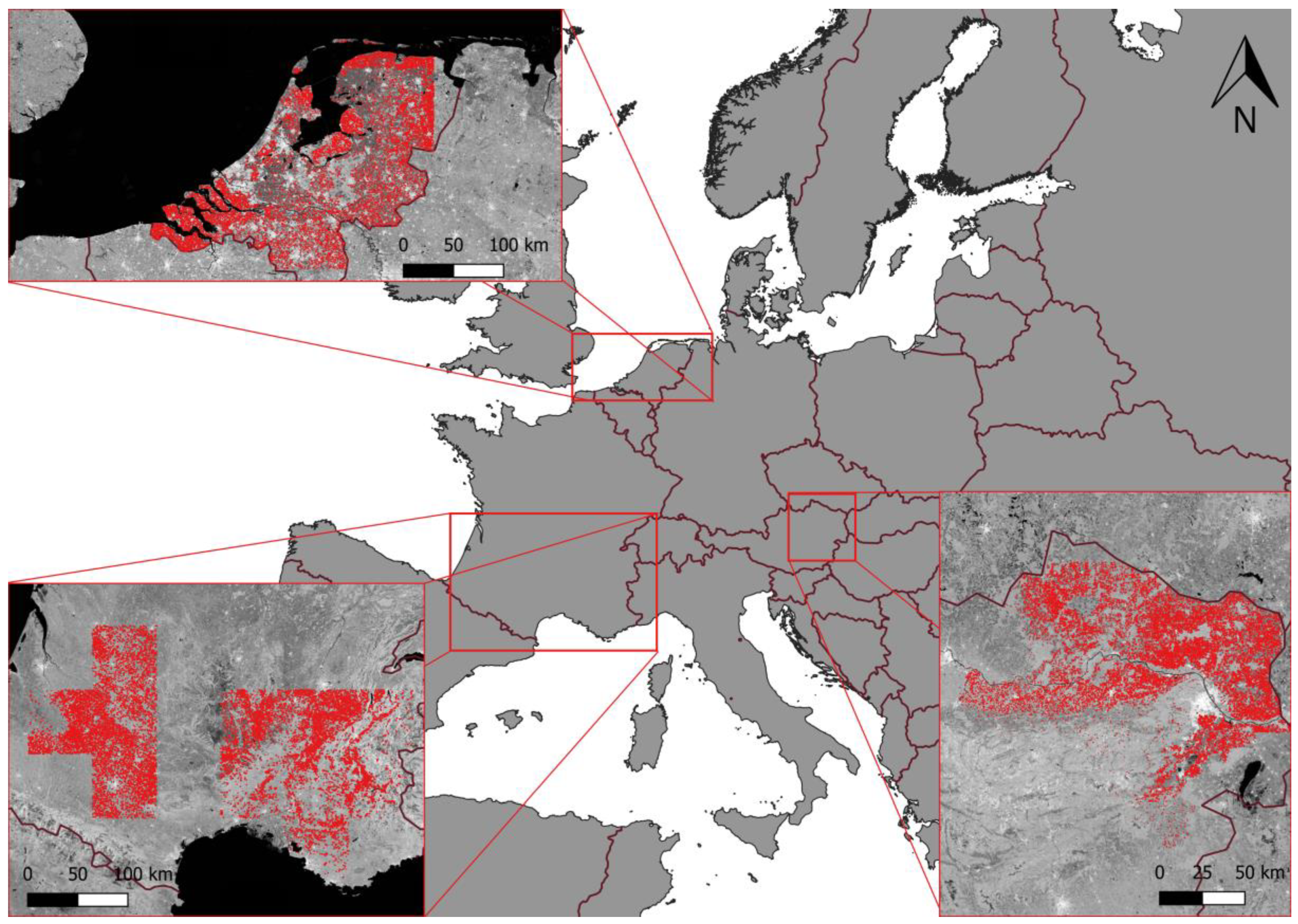

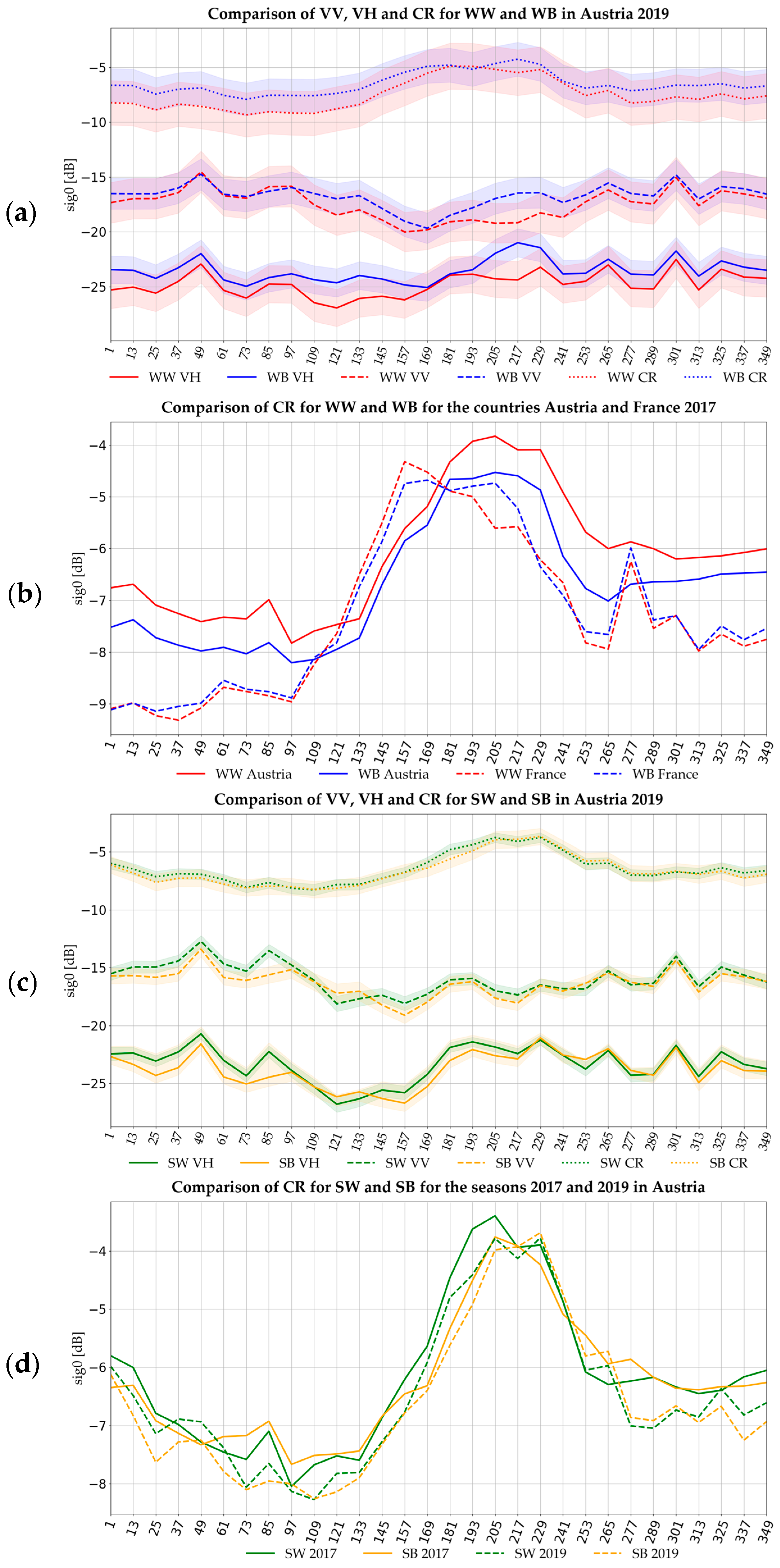
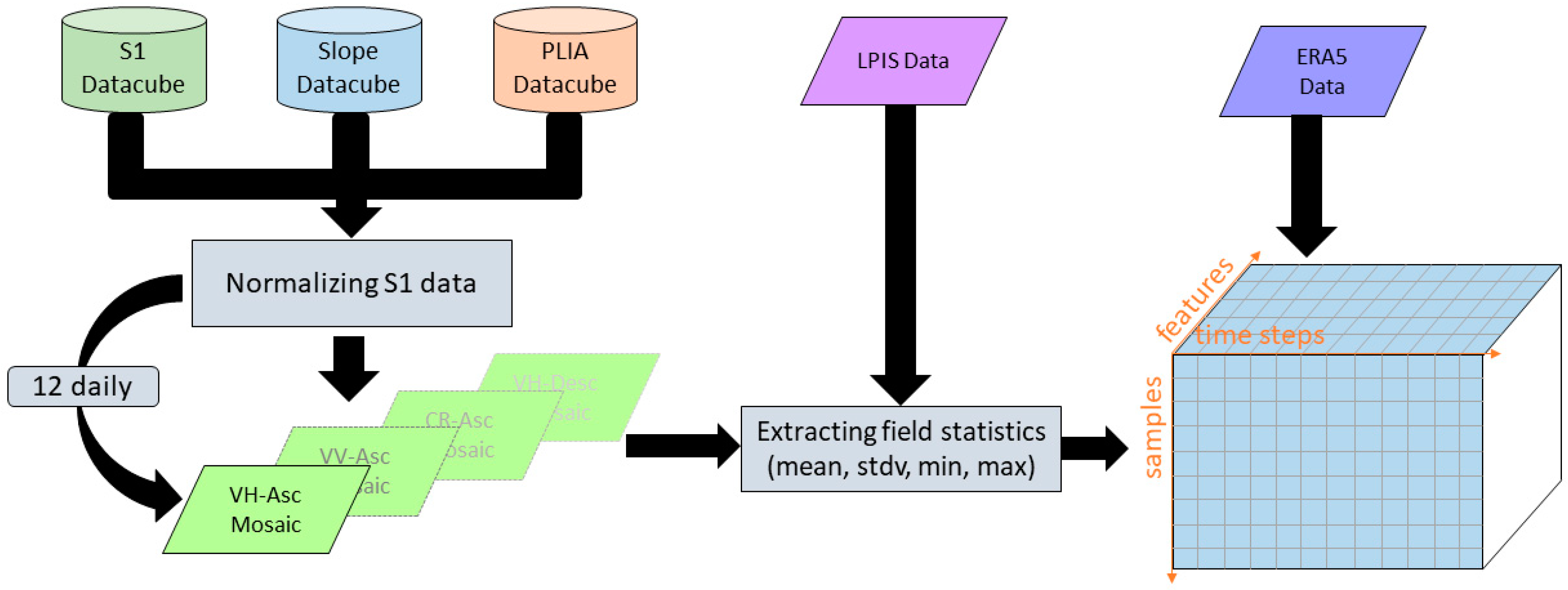

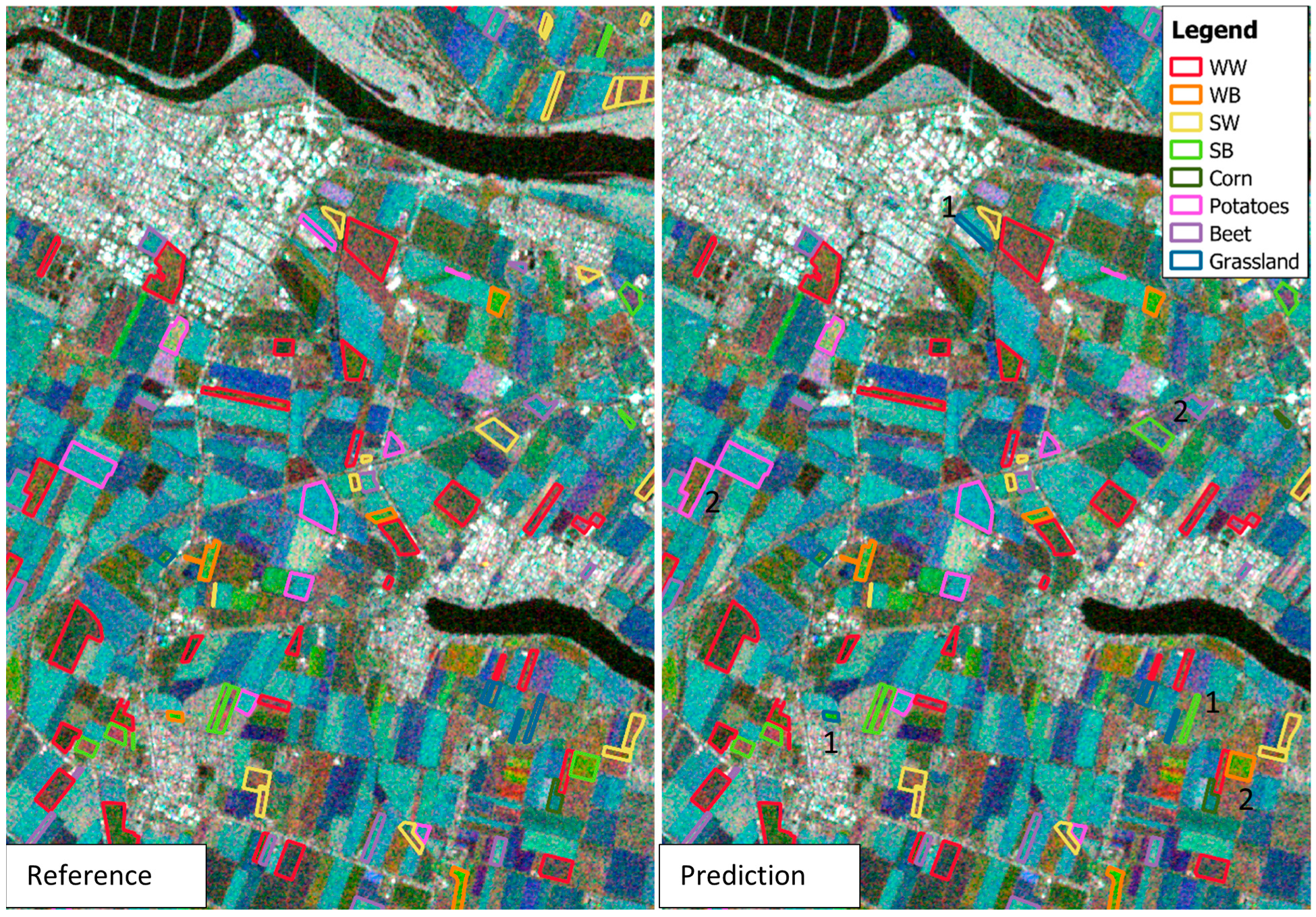
| Crop Type | Austria | Netherlands | France |
|---|---|---|---|
| Winter wheat (WW) | 13,831 | 7500 | 7000 |
| Winter barley (WB) | 13,924 | 4316 | 7000 |
| Summer wheat (SW) | 9997 | 7017 | 3163 |
| Summer barley (SB) | 13,841 | 7500 | 7000 |
| Corn | 13,933 | 7500 | 7000 |
| Beet | 13,188 | 7500 | 3535 |
| Potatoes | 11,732 | 7500 | 2982 |
| Grassland | 13,816 | 7500 | 6635 |
| Total | 104,262 | 56,333 | 44,315 |
| Scenario | 1: Single Season/Singles Country | 2: All Seasons/Single Country | 3: All Seasons/All Countries |
|---|---|---|---|
| Sub-scenarios | Austria 2016 Austria 2017 Austria 2018 Austria 2019 Netherlands 2016 Netherlands 2017 Netherlands 2018 France 2016 France 2017 | Austria 2016–2019 Netherlands 2016–2018 France 2016–2017 | / |
| Crop Type | Single Season/Single Country | All Seasons/Single Country | All Seasons/All Countries | |||
|---|---|---|---|---|---|---|
| LSTM | RF | LSTM | RF | LSTM | RF | |
| WW | 0.92 | 0.89 | 0.87 | 0.83 | 0.85 | 0.80 |
| WB | 0.90 | 0.88 | 0.88 | 0.83 | 0.88 | 0.81 |
| SW | 0.73 | 0.79 | 0.79 | 0.69 | 0.78 | 0.73 |
| SB | 0.79 | 0.78 | 0.82 | 0.78 | 0.81 | 0.75 |
| Corn | 0.90 | 0.91 | 0.88 | 0.86 | 0.88 | 0.83 |
| Potatoes | 0.93 | 0.92 | 0.88 | 0.86 | 0.88 | 0.86 |
| Beet | 0.94 | 0.94 | 0.94 | 0.90 | 0.90 | 0.90 |
| Grassland | 0.93 | 0.88 | 0.92 | 0.88 | 0.93 | 0.83 |
| OA | 0.87 | 0.87 | 0.87 | 0.84 | 0.87 | 0.81 |
| Data | FDR1 | Accuracy | Run Time (in Hours) | ||
|---|---|---|---|---|---|
| LSTM | RF | LSTM | RF | ||
| Netherlands, 2017 | 0.23 | 0.92 | 0.93 | 8 | 0.2 |
| Netherlands, 2015–2018 | 0.29 | 0.93 | 0.91 | 25 | 5 |
| France, 2017 | 0.47 | 0.84 | 0.90 | 7 | 2 |
| France, 2016–2017 | 0.50 | 0.85 | 0.85 | 14 | 4 |
| Austria, 2018 | 0.76 | 0.83 | 0.77 | 9 | 3 |
| Austria, 2015–2019 | 0.84 | 0.84 | 0.80 | 38 | 7 |
| All seasons/all countries | 0.91 | 0.87 | 0.81 | 76 | 19 |
| Crop Type | All Seasons/All Countries | |
|---|---|---|
| LSTM | RF | |
| Winter Wheat | +0.02 | 0 |
| Winter Barley | +0.01 | +0.01 |
| Summer Wheat | +0.02 | −0.03 |
| Summer Barley | +0.03 | +0.03 |
| Corn | 0 | 0 |
| Potatoes | 0 | 0 |
| Beet | +0.01 | −0.01 |
| Grassland | +0.06 | 0 |
| OA | +0.02 | 0 |
| Precision | Recall | F1 Score | |
|---|---|---|---|
| RF | 0.86 | 0.80 | 0.83 |
| LSTM | 0.91 | 0.94 | 0.93 |
| Precision | Recall | F1 Score | |
|---|---|---|---|
| Without meteorological data | 0.91 | 0.82 | 0.87 |
| With meteorological data | 0.91 | 0.94 | 0.93 |
Publisher’s Note: MDPI stays neutral with regard to jurisdictional claims in published maps and institutional affiliations. |
© 2021 by the authors. Licensee MDPI, Basel, Switzerland. This article is an open access article distributed under the terms and conditions of the Creative Commons Attribution (CC BY) license (https://creativecommons.org/licenses/by/4.0/).
Share and Cite
Reuß, F.; Greimeister-Pfeil, I.; Vreugdenhil, M.; Wagner, W. Comparison of Long Short-Term Memory Networks and Random Forest for Sentinel-1 Time Series Based Large Scale Crop Classification. Remote Sens. 2021, 13, 5000. https://doi.org/10.3390/rs13245000
Reuß F, Greimeister-Pfeil I, Vreugdenhil M, Wagner W. Comparison of Long Short-Term Memory Networks and Random Forest for Sentinel-1 Time Series Based Large Scale Crop Classification. Remote Sensing. 2021; 13(24):5000. https://doi.org/10.3390/rs13245000
Chicago/Turabian StyleReuß, Felix, Isabella Greimeister-Pfeil, Mariette Vreugdenhil, and Wolfgang Wagner. 2021. "Comparison of Long Short-Term Memory Networks and Random Forest for Sentinel-1 Time Series Based Large Scale Crop Classification" Remote Sensing 13, no. 24: 5000. https://doi.org/10.3390/rs13245000
APA StyleReuß, F., Greimeister-Pfeil, I., Vreugdenhil, M., & Wagner, W. (2021). Comparison of Long Short-Term Memory Networks and Random Forest for Sentinel-1 Time Series Based Large Scale Crop Classification. Remote Sensing, 13(24), 5000. https://doi.org/10.3390/rs13245000





